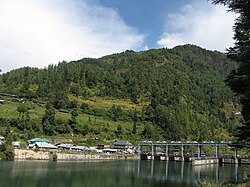Barot, Himachal Pradesh
Barot, Himachal Pradesh
Barot बरोट | |
|---|---|
village | |
| Population | |
| • Total | 2,000 (app.) |

Barot is a picnic spot and tourist location in Mandi district in the Indian state of Himachal Pradesh. It is situated 40 km from Jogindernagar and 66 km from Mandi, the district headquarters.
Accessibility
By Road
Barot is situated 25 km off National Highway 20. The diversion to Barot is at a village, Ghatasani, 14 km from Jogindernagar and 35 km from Mandi. This bye road passes through Jhatingri and Tikkan. From Tikkan, the road runs along the Uhl river till Barot. A major portion of this road is single lane, though not one way.
Barot is connected by public buses to Mandi, Jogindernagar and Palampur. Buses plying to Kothikodh, Bada Gran and Luhardi also pass through Barot.
Railway
The closest railway station is at Jogindernagar, terminus of the narrow gauge railway line connecting Jogindernagar to Pathankot. The line is operated by Northern Railways, a division of Indian Railways.
Other modes
A haulage trolley of the British times connects Barot to Jogindernagar. This trolley link was set up to facilitate transport of construction material to Barot for a reservoir on Uhl river for Shanan Power House. The trolley was also sparingly used as a means of transport since Barot was not linked to a road till 1975. However, once the road connection was established, the trolley fell into a state of disrepair. It is currently owned and maintained by the Punjab State Electricity Board. Currently, the trolley is not in use and is only operated for occasional inspections of the project pipelines.
History
Historically, Barot formed part of the Mandi riyasat before and during British times and was governed by the King of Mandi. Pre Independence, Barot was also on the mule trail connecting Kullu valley to Kangra valley. The importance of this route declined once Kullu was connected to a road from Mandi.
Geography
Barot is situated in a small V-Shaped valley formed by the Uhl river. Surrounded on both sides by parts of the Dhauladhar range of the Himalayas, Barot is located at an elevation of 1819 metres above the mean sea level. Most of the village is settled along the banks of Uhl on both sides. The Uhl barrage and reservoir for the Shanan Power House are a major geographical feature of Barot. Most of the forest around Barot is Deodar and Himalayan Oak.
Tourism
Barot is a frequent backpacker and day tourist destination. Many trekking trails pass through Barot, including trails to Bada Bhangal, Manali and Kullu. Most of the day tourists as attracted by the serene surroundings and cheap availability of accomodation.
Of late, Barot is also developing into an angling destination. The Uhl river supports Trout breeding and Barot has a few fish farms. Across the river Uhl is the Nargu wildlife sanctuary, home to Ghoral, Himalayan Black Bear and a variety of pheasants.
References
- ^ Bharat Sanchar Nigam Ltd. STD Codes for cities in Himachal Pradesh
- ^ India Post. (EN) Pincode search - Barot
